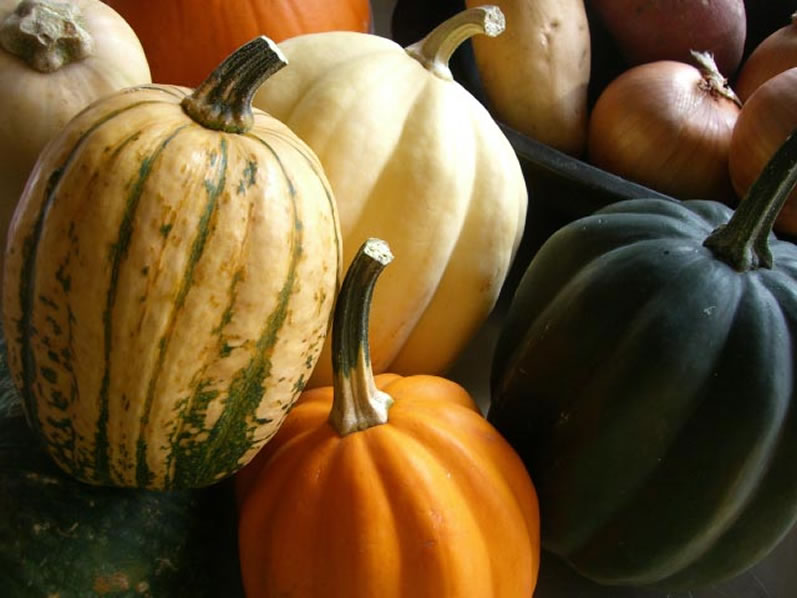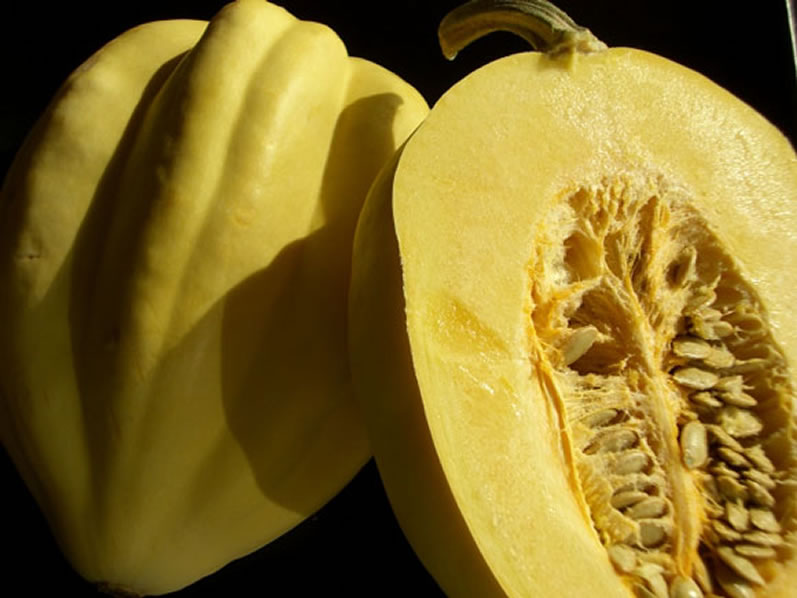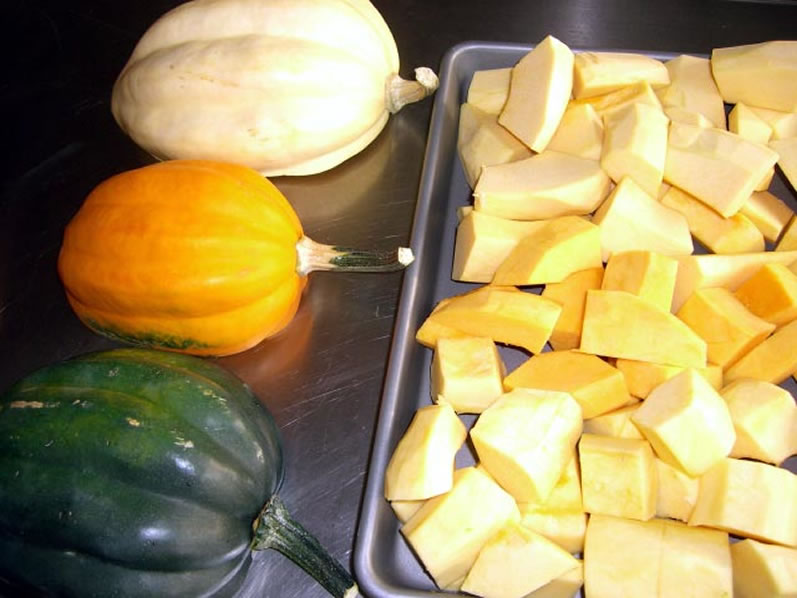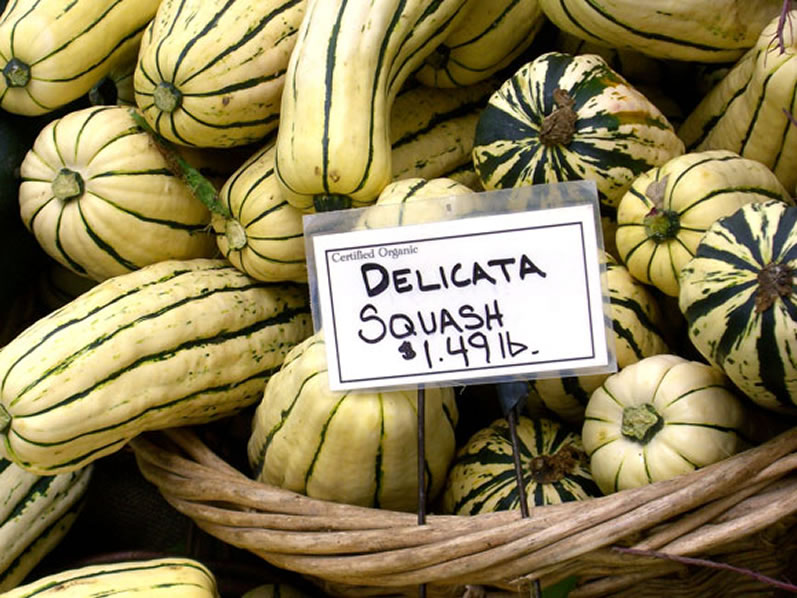 I can think of no better way to spend a Saturday afternoon in October than to wander through Northwest markets ogling the tantalizing displays of winter squash in every conceivable variety, alongside the glorious abundance of dahlias, zinnias, and sunflowers.
I can think of no better way to spend a Saturday afternoon in October than to wander through Northwest markets ogling the tantalizing displays of winter squash in every conceivable variety, alongside the glorious abundance of dahlias, zinnias, and sunflowers.
Pumpkin (which is a winter squash) is the New World vegetable credited with saving the pilgrims from starvation during their first winter. Can you imagine how wonderful that tender, sweet, orange flesh must have tasted in those circumstances? Reminding myself of this bit of history each fall, I stock up on small sugar pumpkins and challenge myself to use them in new and creative ways.
Additionally, winter squash is a most nutritious vegetable, right up there with cabbage, carrots, potatoes, and spinach. It’s a great source of vitamin A and a good source of vitamin C, B vitamins (except B12), potassium, and fiber. Orange-fleshed varieties are high in beta-carotene; the deeper the hue, the greater the dose.
Season
A small selection of winter squash and pumpkin begin trickling into Northwest farmers markets in late September, but the show really gets going in October. The season for pumpkin is short, in that grocers stock up for Halloween, and when that is past, there is hardly a pumpkin anywhere. However, most of the other winter squash varieties are available in good supply through the end of January.
Selection
You will find some of the following varieties in Northwest markets in early October, with more to come in later weeks.
The demarcation “early winter” refers to keeping quality, not harvest time. The thinner-skinned winter squash are “early winter” squash, while the thicker-skinned varieties are “late winter” squash, because they keep over much of the winter months.
Varieties
Acorn/Danish squash
This deeply furrowed squash with golden-orange, dark-green, or cream-white skin and pale orange to yellow flesh is one of my favorite baking squashes. Slice it into halves and fill it with butter and honey, then sprinkle it with cinnamon and nutmeg for a warming delicious treat.
Butternut squash
The lovely buff exterior covers a rich, sweet salmon-colored flesh. The tough shells make them ideal for long-term storage if kept in a dark, dry, cool spot all winter. Nothing is more delicious than butternut squash split down the middle, drizzled with a bit of maple syrup, and then baked until tender.
Delicata squash
The delicata squash, also called sweet potato squash, is considered an early winter squash (along with acorn and sugarloaf). The skin is thin and creamy white with dark green striation along the ribs. The dark orange flesh is sweet and rich, fine-textured and dry. It is excellent for baking. Cut it lengthwise, lightly rub the flesh with olive oil, and bake.
Hubbard squash
Hubbard squash comes in green or baby blue, and both types are excellent. The meat is thick, rich, and finely grained with rich, sweet golden flesh.
Kabocha squash
Japanese Kabocha squash is the behemoth in the winter squash world, weighing anywhere from 2 to 8 pounds. However, 2-3 pounds is what you will most likely find in Northwest markets. This squash is a deep matt green with a pale celadon stripe in the curved indentations. The flesh is vibrant yellow-orange and quite sweet. Kabocha is one of my favorite fall soup squashes.
Red Kuri squash
Red Kuri is a large, teardrop-shaped winter squash with brilliant crimson-orange skin. The flesh is dry, meaty, and sweet. The average weight is five to seven pounds. Red Kuris are perfect for one meal, since each squash serves two to four people nicely. The seed cavity is ideal for stuffing. Red Kuri is one of my favorite fall soup squashes.
Spaghetti squash
Spaghetti squash is a large oval fruit with light yellow to cream colored skin. When fully cooked, the flesh is sweet, light and buttery, the perfect foundation for fresh tomato sauce, or your favorite pasta sauce. The flesh is also stringy and looks like spaghetti when you scoop it out.
Sugarloaf squash
Considered an early winter squash (along with Acorn and Delicata), Sugarloaf squash is a slightly more squat variety of Delicata. The skin is ivory striped with green. The flesh is moist and creamy.
Sweet Dumpling squash
This variety is becoming one of the more appreciated winter squashes. Sweet Dumpling is a wonderful name for this squash. It is small, about three to four inches and has a globe shape. It is a creamy ivory white, green striped squash. Weighing only about seven ounces, it has sweet and tender orange flesh and is a great size for stuffing and baking as individual servings. Sweet Dumpling stores well for up to four months.
Turban squash
This turban-shaped squash is large, with riotous color: bright orange mottled with chartreuse, deep green, and creamy white. The flesh is golden yellow and has a nutty taste.
Good Substitutes
It’s good to know that in virtually any recipe that specifies winter squash or pumpkin, you can substitute sweetpotatoes or yams (or even carrots). The following are readily available in Northwest markets.
Garnet yam
What we in the United States refer to as a yam is actually a variety of sweetpotato. Yams have brilliant orange flesh and are moister and sweeter than sweetpotato varieties labeled as sweetpotatoes. Think of yams as moist-fleshed sweetpotatoes. The garnet yam is a variety of sweetpotato with smooth reddish skin and deep-orange flesh. Are you confused yet?
Hannah sweetpotato
Storage
As soon as there is a good variety of winter squash from which to choose, select what you need for the next 2-3 months and store in a cool, dry location. A root cellar or outbuilding would be ideal, but I keep mine on a covered deck, close to the house, away from wind and rain. The thick, hard shells offer months of protection from spoilage. It’s especially important to stock up on small, sweet pumpkins, as the supply dwindles to nothing after Halloween, and you will want fresh pumpkin for Thanksgiving and Christmas dishes.
Cooking
The winter squash family and its close flavor relative, sweetpotato, has a mellow disposition, with a sweetness level that can be difficult to balance. Some type of acidic ingredient (lemon, lime, green apple, tomatillo, tomato, or vinegar) is usually needed. Also, as is important with most mellow soups, think about including one or more flavor “pops,” to add dimension and continued interest for your diners.
In my recipes, you will see that I often use brightly flavored oil drizzles, as well as dollops of crèma, and garnishes, such as frizzled onions or corn tortillas, toasted coconut shards, or last minute hits of green onion, parsley, or cheese. These garnishes may seem extraneous, but they aren’t, so don’t be tempted to leave them out.
Winter squash range in flavor from very mild to distinctly nutty, with varying degrees of sweetness, but, for all practical purposes, the different varieties are interchangeable in most recipes.
Great Partners
Apple, apple cider, bacon, blue cheese, brown sugar, butter, caramel, caraway, chile, cilantro, cinnamon, coconut, coriander, cream, cream cheese, cumin, currant, curry, dried chile, eggs, garlic, ginger, goat cheese, Gruyere, ham, harissa, hazelnut, honey, leek, lemon, lime, maple syrup, marshmallow, mint, nutmeg, olive oil, onion, orange, Parmesan, parsley, pasta, pear, pineapple, potato, prosciutto, pumpkin seeds, raisin, rosemary, rye flour, sage, sherry, sherry vinegar, sour cream, thyme, vanilla, vinegar, walnut.
LunaCafe Winter Squash & Sweetpotato Recipes
- Basic Spaetzle, Cheese Spaetzle, Herb Spaetzle & Pumpkin Spaetzle
- Perfect Classic Pumpkin Pie + 10 Uncommon Variations
- Curried Sweetpotato, Ginger & Coconut Bisque with Cilantro Lime Oil & Toasted Coconut
- Dreamy, Creamy, No-Bake Pumpkin Butter Cheesecake
- Pumpkin Recipe Roundup
- Pumpkin Pie, Ginger High, Meringue in Your Eye, Oh My
- Pumpkin Ricotta Gnocchi with Garlic Sage Butter
- Pumpkin Sour Cream Pie with Caramel Walnut Topping
- Pumpkin Spice & White Chocolate Cheesecake
- Pumpkin Spice Granola Clusters
- Pumpkin Spice Hot White Chocolate
- Pumpkin, Spice & Everything Nice Tea Bread
- Roasted Fall Vegetable Salad with Warm Goat Cheese & Honey Mustard Vinaigrette
- Savory Pumpkin Honey Dinner Rolls
- Spiced Maple Pumpkin Butter & 20 Ways to Use It
- Spiced Orange Pumpkin Cookies
- Spiced Pumpkin Sour Cream Upside-Down Coffee Cake
- Spicy Pumpkin Butter Gingerbread Beignets
- Sweet Potato Pie Perfecto Mundo
- Warm Spiced Red Kuri Squash & Orange Soup with Cinnamon Harissa
- French Pumpkin Soup with Green Onion & Parsley Persillade (in the works)
- Pumpkin Tomatillo Ginger Bisque with Garlic Chevre Crema & Cilantro Lime Oil (in the works)
- Roasted Butternut Squash Soup with Parsley Scallion Oil & Frizzled Onions (in the works)
- Gratin of Pumpkin, Rice & Cheese (PNP)
- Indian Braised Pumpkin (PNP)
- Pumpkin & Apple Curry (PNP)
- Pumpkin & Cauliflower Strata (PNP)
- Pumpkin & Ginger Ice Cream (PNP)
- Pumpkin & Potato Gratin (PNP)
- Pumpkin Brûlée (PNP)
- Pumpkin Cheesecake with Hazelnut Praline (PNP)
- Pumpkin Cornbread with Maple Butter (PNP)
- Pumpkin Fritters (PNP)
- Pumpkin Hazelnut Torte with Chocolate Glaze (PNP)
- Pumpkin Rum Mousse (PNP)
- Puree of Butternut Squash with Fresh Thyme (PNP)
- Wheat Germ-Fried Pumpkin (PNP)
NOTE PNP = Pacific Northwest Palate: Four Seasons of Great Cooking
Resources



